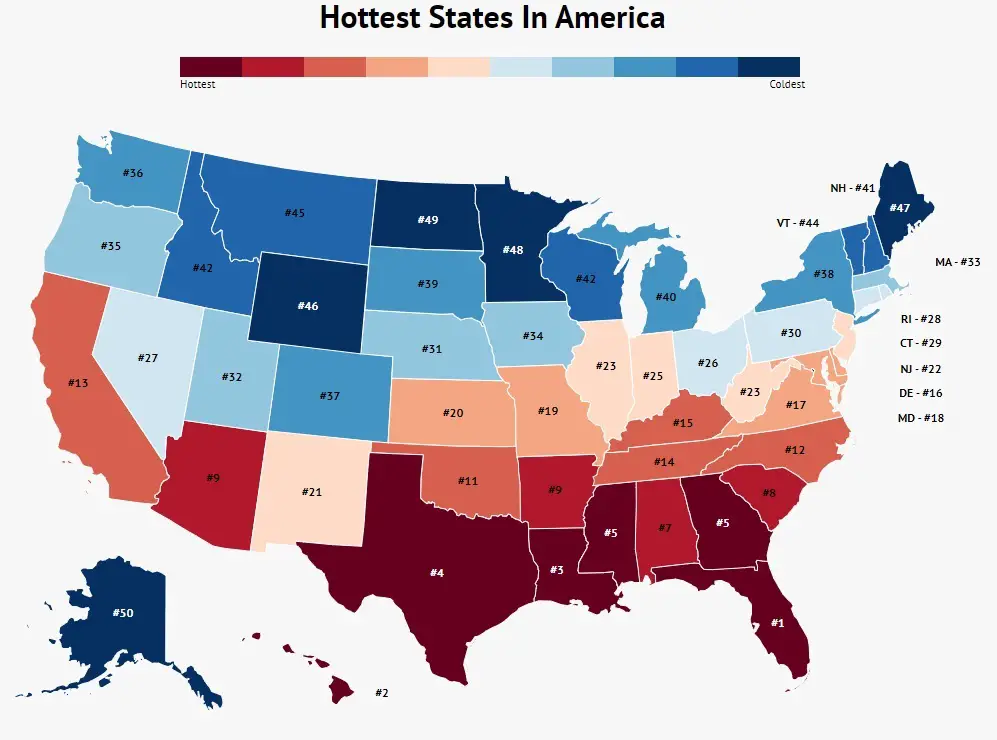When it comes to the topic of what states are the hottest, many people often associate scorching temperatures with deserts and arid climates. However, the reality is more nuanced, as several states across the United States experience extreme heat due to their unique geographical and climatic conditions. In this article, we'll explore the states that consistently rank among the hottest in the country, uncovering why they hold this distinction and how residents and visitors adapt to these soaring temperatures.
Heat is not just a seasonal phenomenon in certain parts of the U.S.; it is a defining characteristic of daily life. From blistering desert landscapes to humid subtropical zones, understanding which states are the hottest can help you prepare for travel, relocation, or simply gain a deeper appreciation for the diverse climates of the nation. Whether you're a sun-seeker or someone who prefers cooler climes, knowing the hottest states is essential knowledge.
This article dives deep into the hottest states in the U.S., examining factors like average temperatures, record-breaking highs, and the unique environmental conditions that contribute to their scorching reputations. By the end, you'll have a clearer picture of which states to visit (or avoid) during the hottest months of the year.
Read also:Exploring The Relationship Between Alex Roe And Jessica Rothe A Deep Dive
Table of Contents
- Introduction to Hot States
- Arizona: The Desert Heat
- Florida: The Sunshine State
- Texas: Big State, Big Heat
- Nevada: Beyond Las Vegas
- New Mexico: A Hot Land
- Factors Contributing to Extreme Heat
- Health Effects of Extreme Heat
- How People Adapt to the Heat
- Heat Statistics Across the U.S.
- Conclusion and Final Thoughts
Introduction to Hot States
Why Some States Are Hotter Than Others
Understanding why certain states are hotter than others requires a look at geography, climate, and atmospheric conditions. States located in desert regions, such as Arizona and Nevada, experience high temperatures due to their arid environments. Meanwhile, states like Florida and Texas endure extreme heat because of their proximity to large bodies of water, which can trap heat and humidity.
Geographical factors play a significant role in determining the hottest states. For instance, elevation, proximity to oceans or large lakes, and prevailing wind patterns all influence temperature levels. Additionally, urban heat islands—areas where concrete and human activity trap heat—can exacerbate temperatures in cities, making them feel even hotter than surrounding rural areas.
Arizona: The Desert Heat
Phoenix: The Hottest City in the U.S.
Arizona is often regarded as the hottest state in the U.S., thanks to its desert climate and scorching summer temperatures. The state capital, Phoenix, consistently ranks as one of the hottest cities in the country, with average high temperatures exceeding 100°F (38°C) during the summer months. The city's record-high temperature of 122°F (50°C) in June 1990 underscores just how intense the heat can be.
Besides Phoenix, other cities in Arizona, such as Tucson and Yuma, also experience extreme heat. Yuma, in particular, holds the distinction of being one of the sunniest places in the world, with over 4,000 hours of sunshine annually. This abundance of sunlight contributes to the state's hot reputation.
Florida: The Sunshine State
Humidity and Heat: A Deadly Combination
While Arizona may boast the highest temperatures, Florida's heat is equally oppressive due to its high humidity levels. The state's subtropical and tropical climate means that even moderate temperatures can feel unbearable because of the moisture in the air. Cities like Miami, Orlando, and Tampa experience humid summers with temperatures often exceeding 90°F (32°C).
Florida's heat is not limited to urban areas; its vast wetlands, such as the Everglades, contribute to the state's overall humidity. This combination of heat and moisture poses unique challenges for residents and visitors alike, making hydration and sun protection essential during the summer months.
Read also:Hisashi Ouchi Real Foto
Texas: Big State, Big Heat
The Diverse Climate of Texas
Texas, the second-largest state in the U.S., is known for its diverse climate, ranging from arid deserts in the west to humid coastal regions in the east. However, the state as a whole experiences significant heat during the summer, with cities like Houston, Dallas, and San Antonio frequently recording temperatures above 100°F (38°C).
One of the factors contributing to Texas's heat is its size. The state's vast expanse means that weather patterns can vary significantly from one region to another. For example, the western part of Texas, which includes cities like El Paso, experiences desert-like conditions, while the eastern regions are more humid and subtropical.
Nevada: Beyond Las Vegas
Death Valley: The Hottest Place on Earth
Nevada, home to the famous Las Vegas Strip, is another state that ranks among the hottest in the U.S. The state's desert climate and elevation contribute to its extreme temperatures. Death Valley, located on the border of California and Nevada, holds the record for the highest air temperature ever recorded on Earth: 134°F (56.7°C) in July 1913.
Beyond Las Vegas and Death Valley, other parts of Nevada, such as Reno and Carson City, also experience significant heat during the summer months. The state's arid environment means that temperatures can fluctuate dramatically between day and night, with cooler evenings providing some relief from the daytime heat.
New Mexico: A Hot Land
Desert Climates and Cultural Adaptations
New Mexico, another state with a desert climate, experiences intense heat during the summer months. The state's capital, Santa Fe, and its largest city, Albuquerque, both see temperatures regularly exceeding 90°F (32°C) in June, July, and August. However, New Mexico's heat is mitigated somewhat by its higher elevations, which provide cooler temperatures in the mountainous regions.
Cultural adaptations to the heat are evident in New Mexico's architecture, where adobe buildings with thick walls help regulate indoor temperatures. Native American tribes and Spanish settlers have long used these techniques to cope with the state's harsh climate, and modern residents continue to benefit from these traditional methods.
Factors Contributing to Extreme Heat
Geography and Climate Patterns
Several factors contribute to the extreme heat experienced in the hottest states. Geography plays a crucial role, with desert regions and low-lying areas prone to higher temperatures. Additionally, climate patterns such as El Niño and La Niña can influence temperature fluctuations, while urbanization and deforestation exacerbate heat in cities.
Global warming is also a significant factor, as rising greenhouse gas emissions lead to higher average temperatures worldwide. This trend is particularly noticeable in already hot regions, where even slight increases in temperature can have profound effects on ecosystems and human health.
Health Effects of Extreme Heat
Heat-Related Illnesses and Prevention
Extreme heat poses significant health risks, including heat exhaustion, heat stroke, and dehydration. Vulnerable populations, such as the elderly, young children, and those with pre-existing medical conditions, are especially at risk during heatwaves. To mitigate these risks, public health officials recommend staying hydrated, seeking shade, and using air conditioning during the hottest parts of the day.
Communities in the hottest states often implement emergency measures during heatwaves, such as opening cooling centers and providing free water distribution. Education campaigns about heat-related illnesses are also essential in helping residents and visitors stay safe during the summer months.
How People Adapt to the Heat
Technological and Behavioral Solutions
Residents of the hottest states have developed various strategies to cope with extreme heat. Technological solutions, such as air conditioning and evaporative coolers, are widely used to maintain comfortable indoor temperatures. Behavioral adaptations, such as limiting outdoor activities during the hottest parts of the day and wearing lightweight clothing, also play a crucial role in heat management.
Urban planning and infrastructure development have also focused on mitigating the effects of heat. Green spaces, reflective roofing materials, and shaded walkways are examples of design features that help reduce urban heat island effects. These initiatives not only improve quality of life but also contribute to environmental sustainability.
Heat Statistics Across the U.S.
Record-Breaking Temperatures and Trends
Data from the National Oceanic and Atmospheric Administration (NOAA) shows that the hottest states in the U.S. consistently experience record-breaking temperatures. For example, Arizona's average high temperature in July is over 105°F (40°C), while Florida's average summer temperature hovers around 90°F (32°C). These statistics underscore the need for effective heat management strategies and public awareness campaigns.
Long-term trends indicate that temperatures are rising across the U.S., with the hottest states experiencing the most significant increases. This trend is expected to continue, highlighting the importance of addressing climate change and its impact on public health and the environment.
Conclusion and Final Thoughts
In conclusion, the hottest states in the U.S. are a fascinating study in geography, climate, and human adaptation. From the scorching deserts of Arizona and Nevada to the humid subtropical regions of Florida and Texas, each state offers unique challenges and opportunities for those living and visiting there. Understanding the factors that contribute to extreme heat and learning how to adapt to it is essential for maintaining health and well-being in these regions.
We encourage you to share this article with others who may be interested in learning more about the hottest states in the U.S. Your feedback and comments are also welcome, as they help us improve our content and provide valuable insights for future articles. Thank you for reading, and stay cool!



